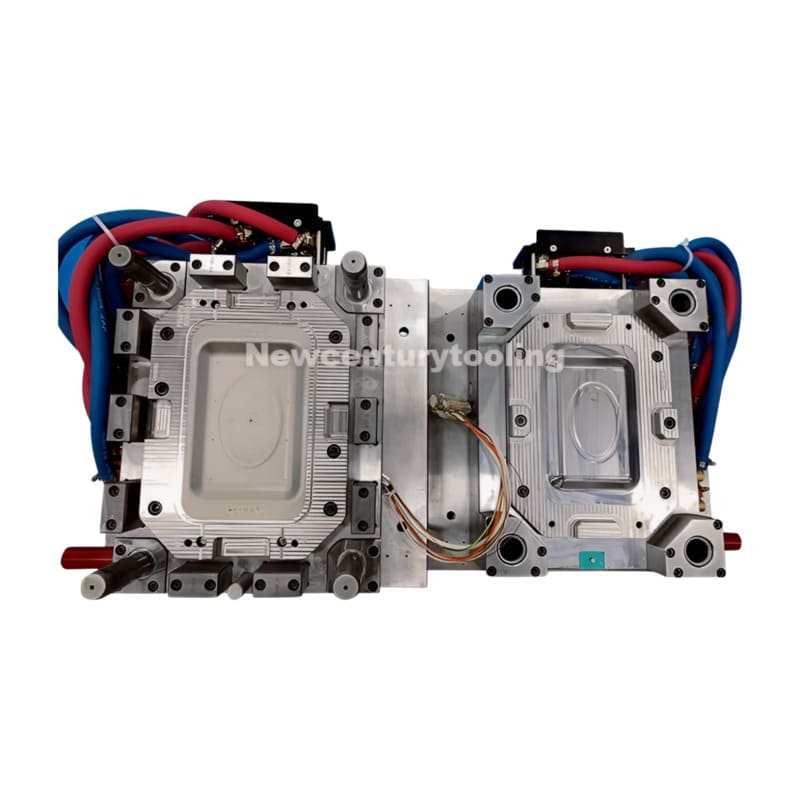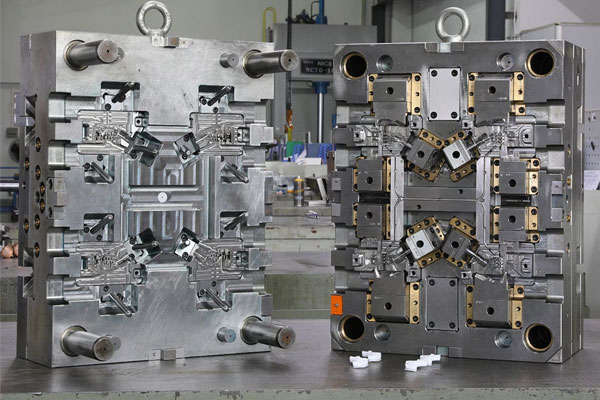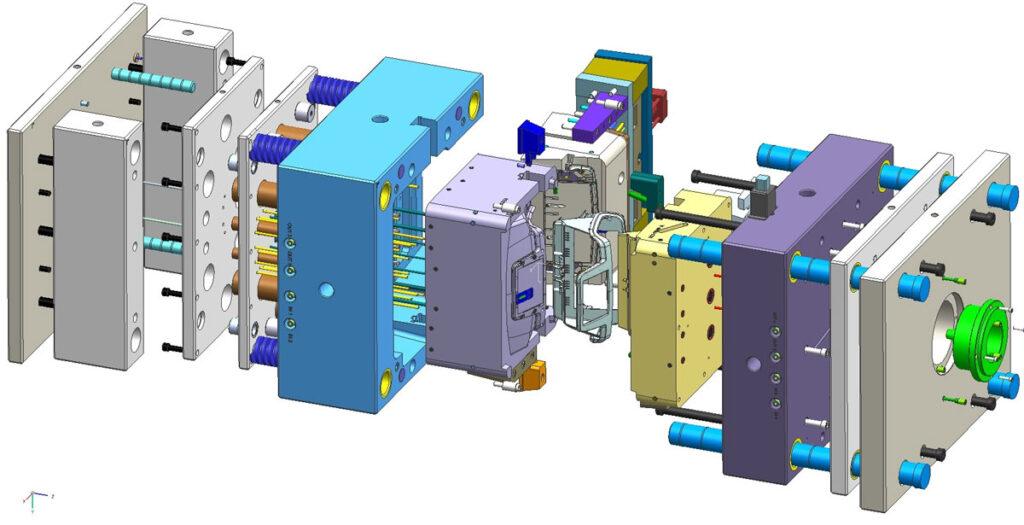Introduction
The mould industry is a basic industry in the manufacturing industry and the basis for the transformation of technological achievements. It is also an important field of high-tech industry. In industrialized countries such as Europe and the United States, it is known as the “magnetic industry” that “turns iron into gold”.
The American industry believes that “the mould industry is the cornerstone of American industry”; Germany believes that it is the “key industry” among all industries; the Japanese mould Association also believes that “moulds are the driving force for promoting social prosperity and wealth”, and are also “the secret of the entire industrial development” and “the driving force for entering a wealthy society.”

Mould opening direction and parting line
When designing each injection moulding product, the mould opening direction and parting line must be determined first to ensure that the core pulling slider mechanism is minimized and the influence of the parting line on the appearance is eliminated.
1.After the mould opening direction is determined, the product’s reinforcement ribs, buckles, protrusions and other structures should be designed to be consistent with the mould opening direction as much as possible to avoid core pulling, reduce the seam line and extend the mould life.
2.After the mould opening direction is determined, the appropriate parting line can be selected to avoid undercuts in the mould opening direction to improve the appearance and performance.
Demolding slope
1.Appropriate demoulding angle can avoid product roughness (drawing). The demoulding angle of smooth surface should be ≥0.5 degrees, that of fine leather grain (sand surface) should be greater than 1 degree, and that of rough leather grain should be greater than 1.5 degrees.
2.Appropriate demoulding angle can avoid product damage, such as top whitening, top deformation, and top breakage.
3.When designing deep cavity structure products, the outer surface slope should be greater than the inner surface slope as much as possible to ensure that the mold core is not offset during injection molding, obtain uniform product wall thickness, and ensure the material strength of the product opening.
Product wall thickness

1.Various plastics have a certain range of wall thickness, generally 0.5 to 4 mm. When the wall thickness exceeds 4 mm, it will cause the cooling time to be too long, resulting in shrinkage and other problems. You should consider changing the product structure.
2.Uneven wall thickness will cause surface shrinkage.
3.Uneven wall thickness will cause pores and weld marks.
Strengthen the ribs
1.Reasonable application of reinforcing ribs can increase product rigidity and reduce deformation.
2.The thickness of the reinforcing rib must be ≤ (0.5~0.7)T product wall thickness, otherwise it will cause surface shrinkage.
3.The single-sided slope of the reinforcement should be greater than 1.5° to avoid top injuries.
Rounded Corners
1.If the fillet is too small, it may cause stress concentration in the product and lead to product cracking.
2.If the fillet is too small, it may cause stress concentration in the mold cavity and lead to cavity cracking.
3.Setting reasonable fillets can also improve the processing technology of the mold. For example, the cavity can be directly processed with R cutter milling to avoid inefficient electrical machining.
4.Different fillets may cause the parting line to move. Different fillets or corner cleans should be selected based on actual conditions.
Hole
1.The shape of the hole should be as simple as possible, generally round.
2.The axial direction of the hole is consistent with the mold opening direction, which can avoid core pulling.
3.When the aspect ratio of the hole is greater than 2, the demoulding slope should be set. At this time, the diameter of the hole should be calculated according to the minor diameter (maximum physical size).
4.The aspect ratio of blind holes is generally not more than 4.
5.The distance between the hole and the edge of the product is generally greater than the hole diameter.
Core pulling and slider mechanism of injection mold and avoidance
1.When the plastic part cannot be demolded smoothly in the mold opening direction, a core-pulling slider mechanism should be designed. The core-pulling slider can form a complex product structure, but it is easy to cause defects such as product seams and shrinkage, increase mold costs and shorten mold life.
2.When designing injection molding products, try to avoid core-pulling structures unless there are special requirements, such as changing the hole axis and rib direction to the mold opening direction, and using methods such as cavity core penetration.
Integrated hinge
1.Taking advantage of the toughness of PP material, the hinge can be designed to be integrated with the product.
2.The size of the film used as a hinge should be less than 0.5mm and remain uniform.
3.When injection molding an integrated hinge, the gate can only be designed on one side of the hinge.
Inserts
1.Inserting parts into injection molded products can increase local strength, hardness, dimensional accuracy and set small threaded holes (axles) to meet various special needs. At the same time, it will increase product costs.
2.The insert is usually made of copper, but can also be other metals or plastic parts.
3.The part of the insert embedded in the plastic should be designed with anti-rotation and anti-pullout structures, such as knurling, holes, bends, flattening, shoulders, etc.
4.The plastic around the insert should be appropriately thickened to prevent stress cracking of the plastic part.
5.When designing an insert, you should fully consider how it is positioned in the mold (hole, pin, magnetism)
Logo
Product identification is generally set on a relatively flat inner surface of the product and is in a raised form. It is recommended to set the identification on the surface where the normal direction may be consistent with the mold opening direction to avoid strain.
Injection molding precision
Due to the unevenness and uncertainty of shrinkage during injection molding, the precision of injection molded parts is significantly lower than that of metal parts. The dimensional tolerance of mechanical parts cannot be simply applied. Appropriate tolerance requirements should be selected according to the standard. my country also issued GB/T14486-93 “Dimensional Tolerance of Engineering Plastic Molding Plastic Parts” in 1993. Designers can determine the dimensional tolerance of parts according to the plastic raw materials used and the use requirements of the parts according to the provisions in the standard. At the same time, the appropriate design tolerance accuracy should be determined based on the comprehensive strength of the factory and the design accuracy of the products of the same industry.
Deformation of injection molded parts
Improve the rigidity of the injection molded product structure and reduce deformation. Try to avoid flat structures, reasonably set flanges and concave-convex structures. Set reasonable reinforcement ribs.
Buckle
Design the buckle device to share multiple buckles at the same time, so that the overall device will not fail to operate due to damage to individual buckles, thereby increasing its service life. Then consider adding more rounded corners to increase strength.
The tolerance requirements for buckle-related dimensions are very strict. Too many undercuts can easily cause buckle damage. On the contrary, too few undercuts can make it difficult to control the assembly position or the assembly part may be too loose. The solution is to reserve a way to easily add glue to the mold.
Welding (hot plate welding, ultrasonic welding, vibration welding)
1.Welding can improve the connection strength.
2.Welding can simplify product design.
The contradiction between process and product performance
1.When designing injection molding products, the contradiction between product appearance, performance and process must be considered comprehensively. Sometimes, sacrificing some processability can get a good appearance or performance.
2.When the structural design cannot avoid injection molding defects, try to make the defects occur in the hidden parts of the product.
Relationship between screw column hole diameter and self-tapping screw diameter
Self-tapping screws screw column diameter
M2 1.7mm
M2.3 2.0mm
M2.6 2.2mm
M3 2.5mm
BOSS design principles
1.The pillar should not be used alone as much as possible. It should be connected to the outer wall or used together with reinforcing ribs to enhance the strength of the pillar and make the rubber flow smoother.
2.The height of the pillar is generally not more than two and a half times the diameter of the pillar. A pillar that is too high will cause air to be trapped when the plastic part is molded (if the length is too long, it will cause air holes, burning, insufficient filling, etc.).
3.If the pillar height exceeds two and a half times the pillar diameter, especially the pillar far away from the outer wall, the way to strengthen the pillar strength is to use reinforcing ribs.
4.The shape of BOSS is mainly round, and other shapes are difficult to process.
5.The position of BOSS should not be too close to the corner or outer wall, and should be kept a distance from the outer wall of the product.
6.You can remove some of the thick flesh around the BOSS (i.e. create a crater) to prevent shrinkage and sinking.
7.BOSS draft angle: usually 0.5° outside and 0.5° or 1 inside.

